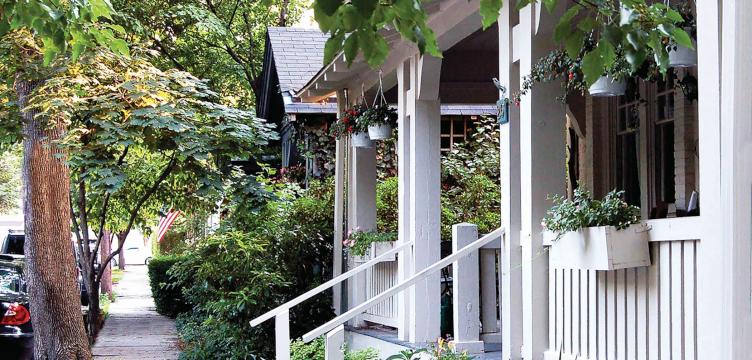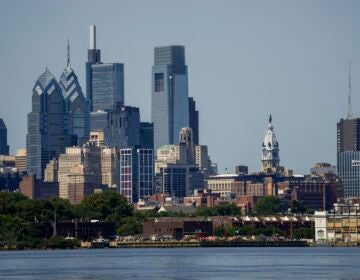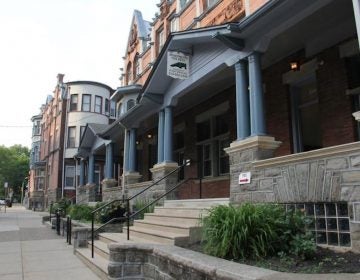Philadelphia moves toward legalizing granny flats in historic buildings
A measure allowing these “accessory dwelling units” (ADUs) on historically designated properties won approval Tuesday from the city’s Planning Commission.

A new bill would legalize accessory dwelling units in historic buildings, like the Benezet Street houses pictured. (Carol Franklin/Chestnut Hill Conservancy and Historical Society)
Philadelphia could soon see more ‘granny flats” in historic buildings.
A bill allowing these “accessory dwelling units” (ADUs) on historically designated properties won approval Tuesday from the city’s Planning Commission. The nod advanced a policy change that backers hope could help ease the burden of preserving creaky old houses while addressing increasing demand for both affordable housing and dwellings suitable for aging in place.
“ADUs are not a new concept, my father actually grew up in one, but they have gained popularity around the country recently as a means to provide additional income to families that might otherwise be displaced in gentrifying neighborhoods,” said Mason Austin, a Planning Commission staffer.
If the legislation continues to move forward and the dwellings are legalized within historic properties, Philadelphia will join a growing number of U.S. cities that have welcomed them as a tool in the fight against displacement.
The ADU bill was one of three introduced by City Councilman Mark Squilla on the last day of the council’s spring session. Another bill in the package aims to eliminate parking requirements for historic structures. The third allows for greater diversity of uses in protected buildings in some residential neighborhoods. The Planning Commission approved all three. All of the bills would apply only to properties designated as historic by the Philadelphia Historical Commission, or buildings that are within a historic district and determined by the commission to contribute to the historic district’s character.
Granny flat, in-law suite, accessory dwelling — all these terms refer to a separate residential unit created to allow people to live on the same property, often in a backyard, attic, or garage, without sacrificing privacy or autonomy.
Philadelphia’s zoning code does not currently permit these structures in any part of the city. Even so, ADUs defined and provided dimensional standards in the code. That’s because in 2012, when city lawmakers reformed the zoning regs, ADUs came up as a tool to address the needs of elderly residents and homeowners. Pushback from community groups in the Northeast prevented them from being legalized in any corner of the city, despite their inclusion in the code.
“It’s a solution looking for a problem,” Councilman Brian O’Neill, who represents half of the Northeast, told PlanPhilly at the time.
The bill now under consideration eliminates an 800-square-foot size limit for ADUs, as long as the structures are built on historic properties. But unlike in standard-issue multifamily buildings, the property owner must live in one of the two units.
The proposed policy on accessory dwelling units was the only piece of legislation to avoid criticism at Tuesday’s Planning Commission meeting.
A move to end parking minimums for historic buildings
A bill eliminating parking minimums for historic buildings received pushback from Paul Boni, a local land-use attorney who is a frequent critic of the city’s approach to zoning and preservation. The bill would also reduce by half parking requirements for additions or expansions to historic buildings,
“I believe this bill is overbroad and should not be enacted in its present form,” said Boni, who argued that the city’s parking regulations are already quite generous.
He noted that the code allows buildings to offer parking up to 1,000 feet off-site, so the requirement to provide parking isn’t as onerous for historic properties as it might appear. Two different buildings can also share the same parking lot.
In most residential zoning districts in Philadelphia, the city requires only that three parking spaces be provided for every 10 residential units, which some City Council members and neighborhood groups have criticized for not requiring enough new parking spaces.
“Many [historically designated buildings] are in neighborhoods where on-street parking is already a nightmare,” said Boni. “With the 10-year tax abatement, we already have tax cuts for the rich, we don’t need undue deregulation too.”
The Planning Commission unambiguously recommended the parking legislation, despite the objections.
Zoning for flexibility
Boni found more support for his criticism of the final bill, which would allow greater flexibility for historic buildings in areas zoned for residential or neighborhood commercial uses. Property owners could act as if their buildings were covered by one of the city’s most permissive zoning districts — CMX-3 — which would allow a wide variety of options.
Planning Commission staffer Marty Gregorski said the bill is meant to give property owners a wide variety of options for the reuse of their buildings, making demolition less appealing.
He said the bill would also help prevent situations like a recent case in which a 12,000-square-foot church was zoned for single-family use — making a trip to the Zoning Board of Adjustment necessary and opening up room for lengthy legal challenges.
That’s exactly what happened with St. Laurentius in Fishtown, where an apartment conversion proposal was held up in court for years after its zoning variance was challenged by a neighborhood group.
To raze a historically protected building, property owners have to prove that the structure represents a financial hardship. Gregorski said the legislation would make it harder for owners to make that case.
“This will make it more difficult to tear down one of these buildings because there are so many new uses that would be permitted,” Gregorski said.
Boni argued that the legislation is laced with confusing language. The bill includes a provision requiring the Historical Commission to prove that the building’s “current or former principal use” was as a public, office, retail, commercial, or industrial use. It also says that the CMX-3 zoning will only apply if the use regulations are “less restrictive” — a term that is undefined — than those under the existing zoning.
The CMX-3 zoning district is so permissive that it allows uses such as auto body shops.
Boni said the bill would undermine neighborhood zoning plans that civic groups have painstakingly worked out with the Planning Commission.
Several members of the Planning Commission agreed with Boni, including Pat Eiding, president of the local AFL-CIO labor federation, who said the bill “really needs to be narrowed down.”
The Planning Commission recommended it for passage but only, in the words of city planning and development director Anne Fadullon, “with the understanding that there will be conversations about potential amendments that will clarify what uses will be allowed.”
The first day of City Council’s fall session is Sept. 12, and Gregorski said he didn’t anticipate a Council hearing on the bills until October. That means they wouldn’t wind up on Mayor Jim Kenney’s desk until the end of that month.
Squilla introduced the three bills at the end of the spring session with the support of the mayor, who has been under pressure to address historic preservation since the city’s iconic Jewelers’ Row was threatened with partial demolition near the beginning of his term.
The bills are seen as part of a strategy to incentivize historic preservation in the city, although they fall short of the “demolition delay” legislation that many preservation advocates call for.
“We want to preserve the structures that we have, but if we don’t give incentives and give [property owners] options, they are going to fight this,” Squilla said June 20, the day he introduced the bills. If that happens, “we will end up losing a lot of what makes Philadelphia Philadelphia.”
WHYY is your source for fact-based, in-depth journalism and information. As a nonprofit organization, we rely on financial support from readers like you. Please give today.







